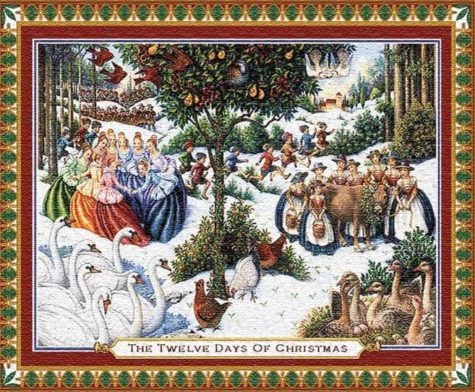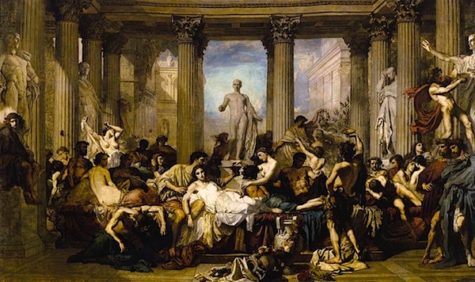Daily Archives: December 7, 2016
From the earliest times the twelve days have been regarded as a time when supernatural events can easily happen, when the dead are close at hand and might often be seen.
One reads of the Wild Hunt, or the Fairy Host riding across the lands of Britain and Germany in particular, led by characters such as King Arthur, Woden, and Arawn, the Celtic god of the Underworld. In Ireland these supernatural hunters are known as the Yule Host, and in common with all these bands they are believed to gather up wandering souls and carry them away to the Otherworld.
The Twelve Days of Christmas stand outside of “ordinary time,” and celebrations focus on the return of the sun and a continuation of the eternal cycle of life.
The days from Christmas Eve on December 24th to Epiphany on the 6th of January (actually fourteen days as the first and last are not included in the twelve) really exist out of linear time. They are, in a sense, the fruit of the past year, one day for each month that has passed. Over the centuries the dates have changed – sometimes radically.
Here’s a list of commonly accepted dates and traditions:
- Day 0 – Dec 24 – Christmas Eve
- Day 1 – Dec 25 – Christmas Day, Birthday of Jesus, Mithras, Attis, Aion, Horus, Dionysus, and The Unconquered Sun.
- Day 2 – Dec 26 – St Stephen’s Day, Boxing Day, Day of the Wren
- Day 3 – Dec 27 – Mother Night, St John’s Day
- Day 4 – Dec 28 – Holy Innocent’s Day, Childremass, Dyzymas Day
- Day 5 – Dec 29 – Feast of Fools
- Day 6 – Dec 30 – Bringing in the Boar
- Day 7 – Dec 31 – New Year’s Eve, Hogmanay
- Day 8 – Jan 1 – New Year’s Day,
- Day 9 – Jan 2 – The Kalends of January
- Day 10: – Jan 3 – Snow Day
- Day 11 – Jan 4 – Evergreen Day
- Day 12 – Jan 5 – Twelfth Night
- Day 13 – Jan 6 – Epiphany,
When researching lore and magicks for the Twelve Days of Christmas I found a lot of disagreement as to the dates. So, from Wikipedia we have this explanation and additional information:
The Twelve Days of Christmas are the festive days beginning Christmas Day (25 December). This period is also known as Christmastide and Twelvetide. The Twelfth Night of Christmas is always on the evening of 5 January, but the Twelfth Day can either precede or follow the Twelfth Night according to which Christian tradition is followed. Twelfth Night is followed by the Feast of the Epiphany on 6 January. In some traditions, the first day of Epiphany (6 January) and the twelfth day of Christmas overlap.
Over the centuries, differing churches and sects of Christianity have changed the actual traditions, time frame and their interpretations. St. Stephen’s Day (or Boxing Day), for example, is 26 December in the Western Church and 27 December in the Eastern Church.Boxing Day, on December 26, is observed as a legal holiday in parts of the Commonwealth of Nations. 28 December is Childermas or the Feast of the Innocents.
Currently, the twelve days and nights are celebrated in widely varying ways around the world. For example, some give gifts only on Christmas Day, some only on Twelfth Night, and some each of the twelve nights.
In England in the Middle Ages, this period was one of continuous feasting and merrymaking, which climaxed on Twelfth Night, the traditional end of the Christmas season. Continue reading
The Geminids is the king of the meteor showers. It is considered by many to be the best shower in the heavens, producing up to 120 multicolored meteors per hour at its peak. It is produced by debris left behind by an asteroid known as 3200 Phaethon, which was discovered in 1982.
The shower runs annually from December 7-17. It peaks this year on the night of the 13th and morning of the 14th. Best viewing will be from a dark location after midnight. Meteors will radiate from the constellation Gemini, but can appear anywhere in the sky.
Saturnalia was an ancient Roman festival in honor of the deity Saturn. Originally it was held on 17 December of the Julian Calendar, but the party later expanded with festivities through to 23 December. The poet Catullus called it “the best of days”.
Saturn being an ancient national god of Latium, the institution of the Saturnalia is lost in the most remote antiquity. In Roman mythology, Saturn was an agricultural deity who was said to have reigned over the world in the Golden Age, when humans enjoyed the spontaneous bounty of the earth without labor in a state of innocence. The revelries of Saturnalia were supposed to reflect the conditions of the lost mythical age, not all of them desirable. The Greek equivalent was the Kronia.
Falling towards the end of December, at the season when the agricultural labors of the year were completed, it was celebrated by the country-people as a sort of joyous harvest home, and in every age was viewed by all classes of the community as a period of absolute relaxation and unrestrained merriment. The festival was extended in later times to three and still later to seven days.
During the celebration of this holiday no public business could be transacted, the courts were closed, war was suspended, all private enmities were for the time forgotten, and the city was alive with hilarity. On this day the slaves feasted and were waited upon by their masters, as the female slaves were waited upon by their mistresses on the Matronalia.
The special feature of the festival was the gift of wax candles and of little images of wax or clay called sigilla. The public festival, in the time of the republic, was for only one day; but for seven days the celebration continued in private houses.
Many of the customs of the Roman Saturnalia were taken over by the Christian Church in celebrating Christmas. Thus the origin of the Christmas-tree, and the custom of making presents to children and friends may be traced back to the Roman Saturnalia, while the Yule-log and Yule-fire are remnants of ancient sun-worship, one of the Roman festivals in honor of the Sun god being celebrated on the 25th of December as “Dies Natalis Solis Invicti.”
Although probably the best-known Roman holiday, Saturnalia as a whole is not described from beginning to end in any single ancient source. Modern understanding of the festival is pieced together from several accounts dealing with various aspects.
Here’s some History:
Saturnalia festivities began with ritual and sacrifices in the Temple of Saturn. The statue of the god was hollow and filled with olive oil, as a symbol of his agricultural functions. His feet were bound with woolen strips, that were unbound at Saturnalia.
After the rituals, the Senators (who had to be present) dismissed the crowd with the cry of “Io, Saturnalia!”, a sign for the happy festivities of family parties and other private gatherings to begin. The traditional gifts were wax tapers and little dolls, although gifts of silver later became traditional.
The custom of the Lord of Misrule was appropriated and survived through to English Christmas traditions.
The biggest part of Saturnalia was attitude more than decoration. Feasting, drunkenness, merrymaking, hopefully the conception of more children (or at least enjoying those activities which led to conception!), pranks, gift giving, role reversals (not true ones, only symbolic ones – slaves weren’t really free to make a freedman’s decisions and anything they did or decreed would reverse at the end of Saturnalia, children weren’t really adults and could not enter into any binding contracts or make business deals, etc.) and so forth.
The role reversals seemed to be more for minor privileges – slaves and children got to be waited on for meals, and to lead the rituals, and to participate in the revelry as if they were their parents/masters. The parents/masters jokingly played the part of slaves and children by waiting on them and making rude and bawdy jokes at their expense. Sometimes, it descended into cruelty.
Many of the decorations involved greenery – swathes, garlands, wreaths, etc – being hung over doorways and windows, and ornamenting stairs. Ornaments in the trees included sun symbols, stars, and faces of the God Janus. Trees were not brought indoors (the Germans started that tradition), but decorated where they grew.
Food was also a primary decoration – gilded cakes in a variety of shapes were quite popular, and children and birds vied for the privilege of denuding the trees of their treats. The commonest shapes were fertility symbols, suns and moons and stars, baby shapes, and herd animal shapes (although, to be honest, it’s hard to tell if some of those ancient cookie cutters are supposed to be goats or deer). I would imagine coins were also a popular decoration/gift.
People were just as likely to be ornamented as the trees. Wearing greenery and jewelry of a sacred nature was apparently common, based on descriptions, drawings, and the like from the era. Although the emphasis was on Saturn, Sol Invictus got a fair share of the revelry as well.
On a modern note:
This ancient midwinter festival falls at the time when non-Romans are celebrating Christmas, Hanukkah, Solstice and/or Kwanzaa. In Nova Roma, individual Citizens have chosen different approaches to the challenge of celebrating in the spirit of Rome without cutting themselves off from the culture in which they live.
Gold, because the sun is yellow, is always a sure choice for a good Saturnalia decoration. For modern Saturnalia, those golden glass ball ornaments are ideal, as are gold sun faces, gold stars, and gilded anythings. Gilding nuts and pine cones and nestling them among the swags and wreaths of greenery would be a lovely way of acknowledging the ancient roots of this ceremony.
Indoor trees are not ancient Roman, but if you have plants growing indoors, decorating them would certainly be in the spirit of the holidays. If you just have to have the now-traditional indoor tree, try decorating it in gold ornaments with a solar theme. Swathe it in bright red or purple ribbons (2 colors quite in favor with the Romans, and looks great with the gold ornaments). Top the tree with a sun, rather than a star, for after all, this is a solar celebration.
Wild parties with lots of food and drink is good. Letting the children of the household lead the common rituals, and waiting on them (assuming you don’t do so in everyday circumstances….) at mealtimes, and deferring to them in decisions on party ideas would work for role reversals.
No children in the house? Maybe you can borrow one for a day. We don’t have slaves, but, for a nice touch of role reversal, we could purchase the services of a nanny or a housekeeper for the duration of Saturnalia. It would be a role reversal of sorts, for instead of being the slave of your home, someone else would be doing the chores and cooking and childcare while you got to party down!
Dancing and singing in the streets is now frowned upon, unless you can get a parade permit. A parade, if you could organize it, would be fun. Imagine – giant floats of the Gods tended by the priests and acolytes, musicians and dancers, contortionists to amaze and delight, acrobats and jugglers, all in honor of Saturn!
For a compilation of Saturnalia celebrations reported by Nova Romans, visit Saturnalia practices of Nova Romans.






